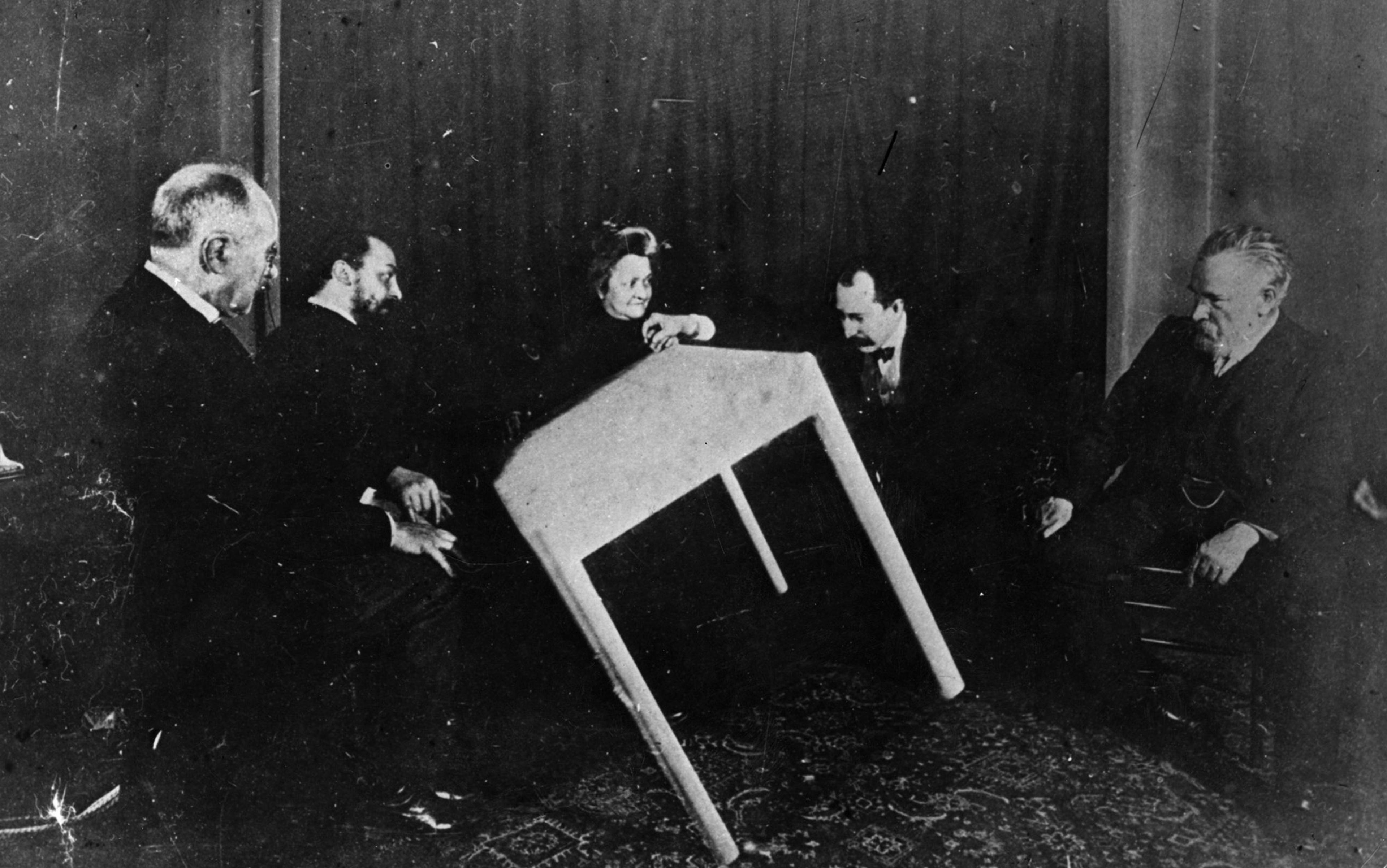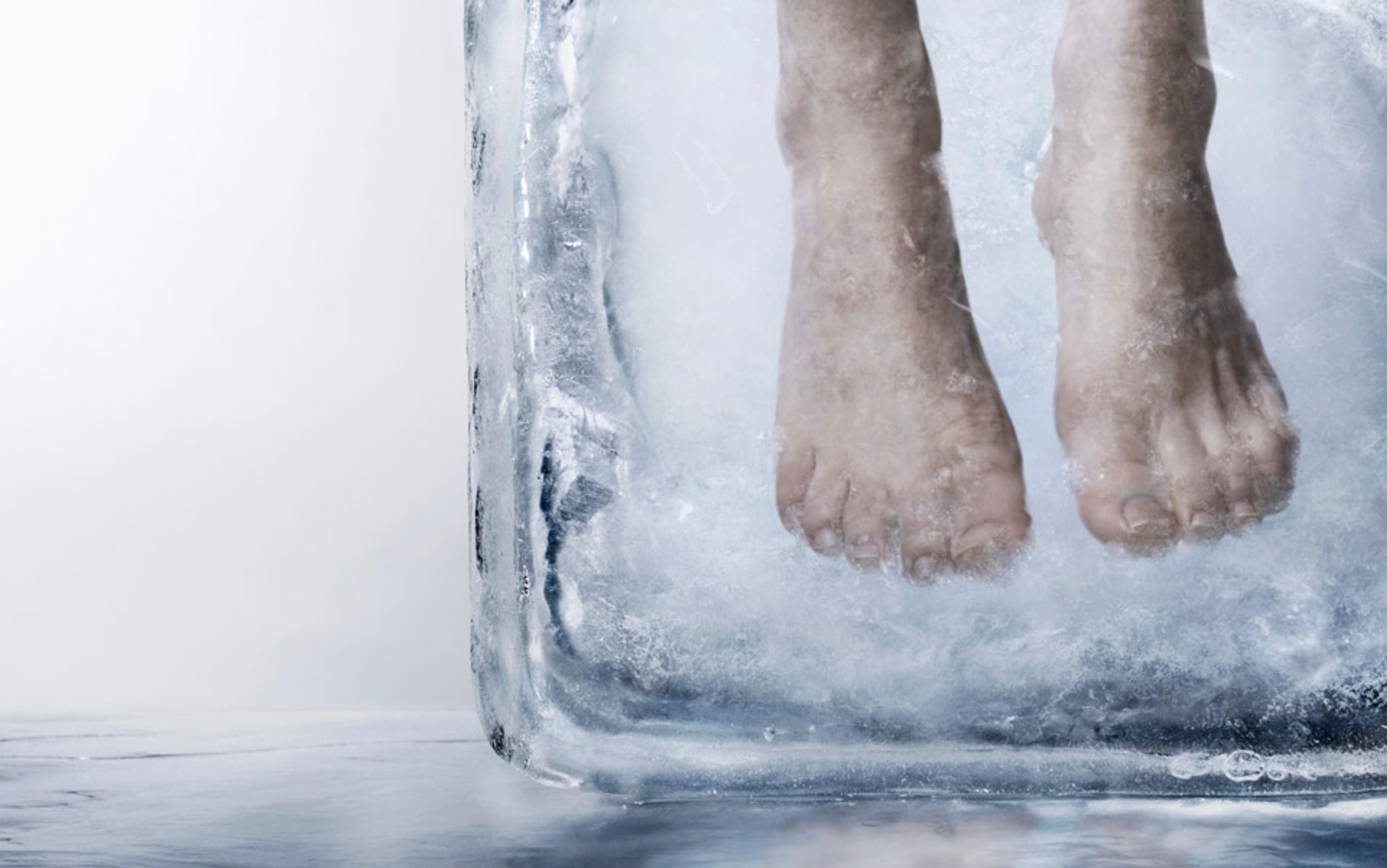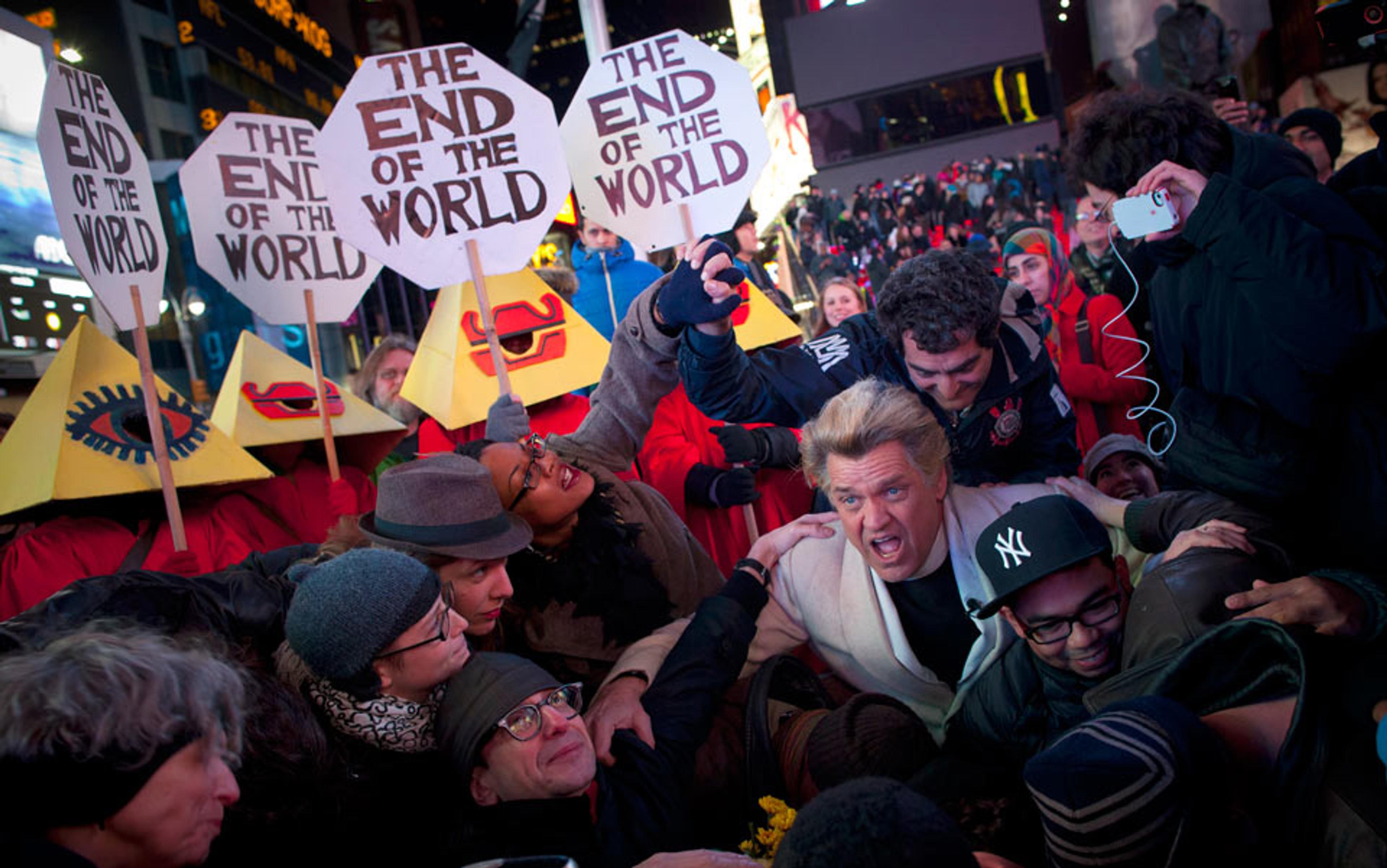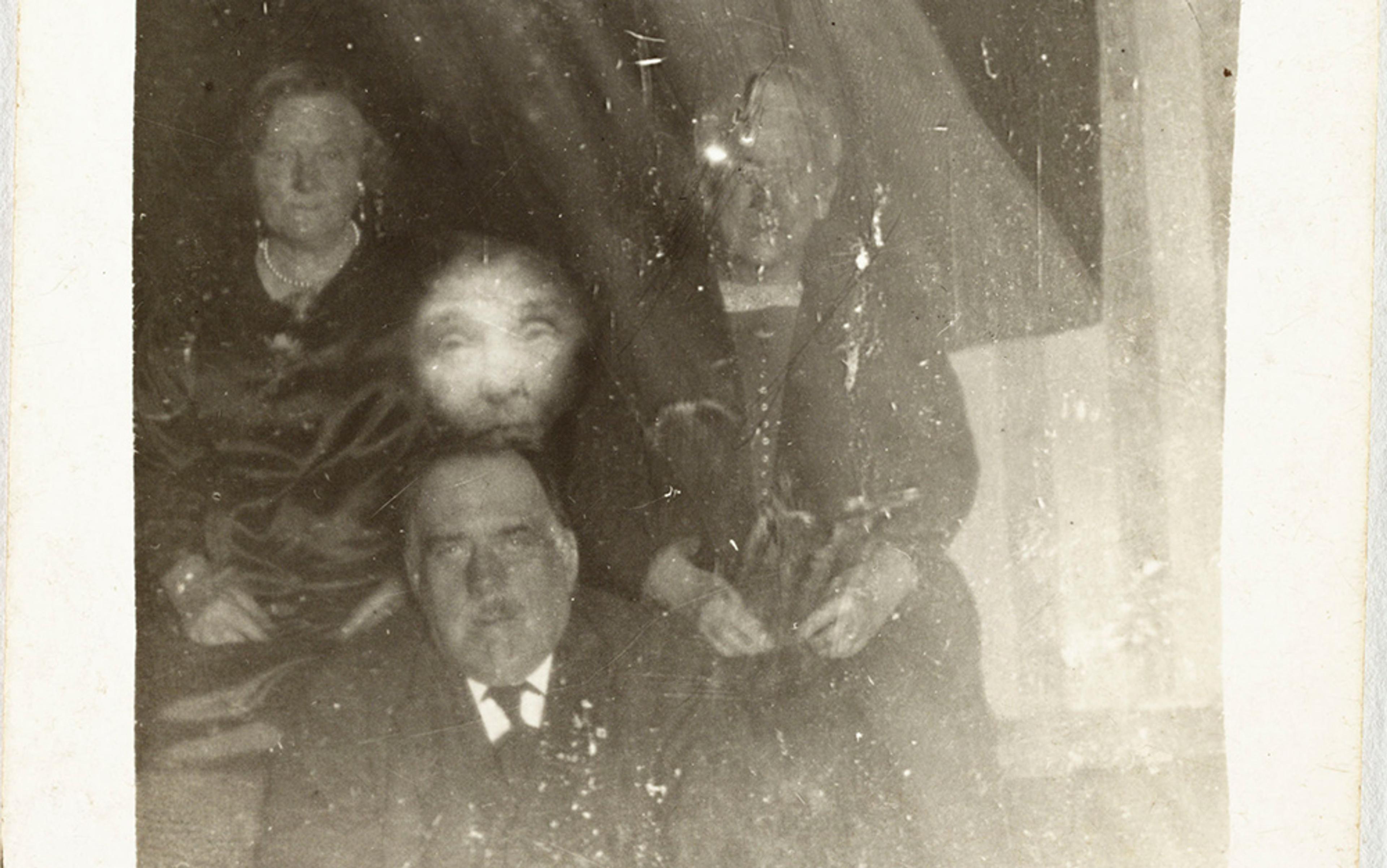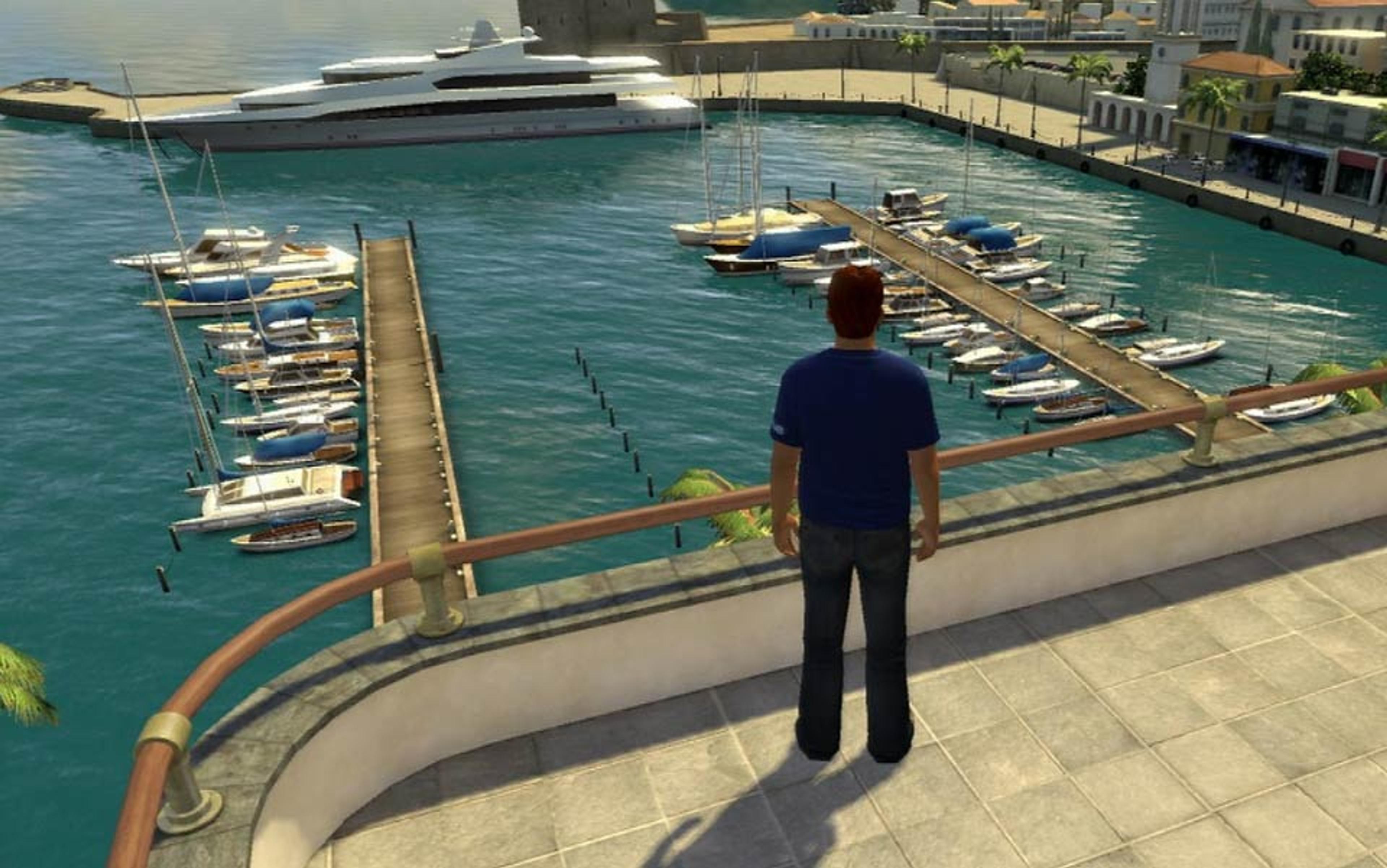She was nothing like the sweet old lady in Poltergeist, a film that gave me, an overly imaginative child growing up in the 1980s, my most memorable brush with the spirit world. In fact, Caroline seemed so down-to-earth that I wondered if she truly believed this stuff. Maybe she just enjoyed pulling people’s legs and catching the money falling out of their pockets.
‘Well, don’t force it,’ I told her. ‘I mean, if he’s not here, he’s not here, right?’
‘Ian’s definitely here,’ she snapped. ‘I feel like he’s outside, not in the house. It’s just, either he doesn’t want to do this, or something won’t let him.’
I thought of Poltergeist again, the final tug-of-war between the forces of good and evil over that creepy little blonde girl, who died of an illness in real life. That’s real life for you. We live and we die: that’s it. If I were to be convinced that there’s more to the afterlife than frauds, wishful thinking and special effects, I’d need evidence. And I’d come here — to a sprawling 300-acre estate just outside Charlottesville, Virginia — to get that evidence from the property’s former owner, Ian Stevenson.
I’d tagged along with Caroline the psychic and Emily Williams Kelly, who has a PhD in parapsychology from the University of Edinburgh, and was a trusted protégé of Professor Stevenson. Stevenson died six years ago, aged 88, after a bout of pneumonia. What happened to his conscious mind after that, or where ‘he’ went, nobody knows. Then again, if the mind is what the brain does, why do we even bother to ask where our minds ‘go’ when our brains power down? Isn’t it obvious that the mind is dead too?
Stevenson had a fascinating mortal existence. In the 1960s, he stepped down from his position as head of the Department of Psychiatric Medicine at the University of Virginia to become a fully fledged parapsychologist. Trading in a successful career studying the disordered minds of the living for one investigating the hypothetical minds of the dead was a risky career move. But Stevenson thrived, quickly becoming a star paranormal researcher. In the 1980s, he even served for a while as president of the Society for Psychical Research in the UK, a high honour for an American.
I should confess that, unlike Stevenson, who made no secret of his lifelong belief in the supernatural, I’m a sceptic. In fact that’s probably putting it too mildly. In my book The Belief Instinct (2011), I reviewed scientific findings from my own research as well as that of my colleagues in the new field of the ‘cognitive science of religion’. I laid out a case for how the human mind evolved to deceive us into believing in a ‘demon-haunted world’, as Carl Sagan put it, because such supernatural beliefs were biologically adaptive — at least they were adaptive tens of thousands of years ago, when our mental abilities were carved out by the godless forces of natural selection. That said, I’d be happy to be proven wrong about the afterlife. As Stevenson once wrote: ‘The wish not to believe can influence as strongly as the wish to believe.’ Sometimes we sceptics are really just cynics.
I was beginning to think that Caroline had a better chance of finding every last particle of Stevenson’s ashes, scattered here after he was cremated, than of picking up the signal to his discarnate consciousness.
‘Shhhh. Wait a minute,’ Caroline said, pointing with her chin to Stevenson’s house. ‘There. He’s up there somewhere.’ Off she trotted, and I followed along with Emily.
Given all the effort Stevenson had put into what he called the ‘combination lock test for survival’, it would be a pity not to try to contact his spirit. He had come up with the idea for the test in the late 1960s after reading about a British widow whose husband died without telling her the combination to a lockbox that held important documents. After many frustrating attempts to open it, the despairing widow said she heard her husband’s voice giving her the code. When she tried that set of numbers — voila! — the lockbox sprung open. Not exactly a bulletproof case, but it got Stevenson thinking.
After consulting with his paranormal research colleagues, Stevenson had the basic study design down pat. First, a person would choose a six-word phrase, something he or she would never forget. ‘I have no fear whatever of forgetting it on this side of the grave,’ Stevenson wrote of his own secret code, ‘and, if I remember anything on the other side, I shall surely remember it’. Whatever it was, the code was to be kept to oneself. This sworn secrecy was critical for the sake of the test.
The subject would then use a special formula, developed by Stevenson, to encrypt the first letters of the six-word phrase into three double-digit pairs. Let’s say your secret code is ‘Storms are more fun than sunshine.’ Using Stevenson’s formula, s, a, m, f, t, s works out to 41-36-19.
Next, you’d set a combination lock using those three numbers. Stevenson recommended the brand Sargent & Greenleaf ‘Model 8088’, one of the few locks that could be set to the owner’s chosen combination. Finally, and most importantly, the time to share your secret code would be after you die, through some sort of message from beyond the grave.
This wasn’t just some fleeting idea scribbled on a bar napkin after a telekinesis conference
The whole affair, in other words, was to be a coordinated effort between the living and the dead. Still, Stevenson worried that the latter might forget all about their promise, or even renege on it. ‘A recently deceased person who survives death will have many new experiences to assimilate,’ Stevenson wrote, ‘and many things on his mind apart from the combination lock that he set.’ All the living could do was hope that the dead kept their word, because if anyone ever managed to spring a deceased’s lock, it would be (for Stevenson) cold, hard proof of the afterlife.
Along with a few other forward-thinking souls, Stevenson set a lock of his own. This wasn’t just some fleeting idea scribbled on a bar napkin after a telekinesis conference. He kept at it, publishing multiple articles on the test over a 25-year period.
However, for one so eager in life, Stevenson hasn’t been very co-operative in death. Ten days after he died in hospital on 8 February 2007, The New York Times ran his obituary, mentioning the lock test. Soon, emails, letters and phone calls besieged the Division of Perceptual Studies (DOPS) at the University of Virginia, the still-active parapsychology unit founded by Stevenson. People from all over the world claimed his spirit had given them the secret code to his personal lock.
‘None of them worked,’ Bruce Greyson, Stevenson’s friend and successor at DOPS, told me. ‘We tried them all. Most of the codes sounded nothing at all like Ian, but we tried them anyway.’ Greyson, a psychiatrist himself and an expert on near-death experiences, is the keeper of the locks, which today mostly collect cobwebs at the bottom of a drawer in his office.
Was all that about to change? Back at Stevenson’s property, Caroline emerged from her bristly cove next to the tennis courts. ‘This is going to sound weird,’ she said. ‘What I heard was: “Feeling free on the courts alone.” He was just repeating that over and over, like a mantra or something.’
‘Feeling … free … on … the … courts … alone.’ Six words. I looked over at Kelly, a seasoned professional who had experience with psychic mediums. ‘Well,’ she said, ‘it’s worth a shot. Ian did like tennis.’
As we didn’t have Stevenson’s lock with us, we had to go back to the University of Virginia where Greyson could decipher the mantra to see if Caroline’s spiritual antennae pointed in the right direction. I took one final glance at the tennis courts, half-expecting to see the ghost of Stevenson spinning a racket and staring back at me for a quick meeting of minds — mine stuck in the recalcitrant brain of a sceptic, his floating freely. Caroline grabbed my elbow and said: ‘Hey. Ian actually gave us a really icy reception. He’s not into us being here. Seriously. You especially. Just so you know, it felt like he was trying to get rid of you.’
Stevenson wasn’t the only scientist to attempt to solve the ageless (non)mystery of what becomes of our minds after death. A new hunt for the soul began in 2012 under John Martin Fischer, professor of philosophy at the University of California, Riverside, and the man in charge of the ‘Immortality Project’. He is funded by a $5 million grant from the John Templeton Foundation, which supports innovative research that seeks to bridge religious and scientific questions. Earlier this year, scholars from across the globe competed for a slice of this tidy sum.
Fischer announced the winning proposals in May. Surprisingly, only one of the 10 projects to be funded deals directly with the juicy question Stevenson was so keen to answer: ‘Do we, or do we not, survive death?’
That prize went to Sam Parnia, director of resuscitation research at the State University of New York at Stony Brook, who plans to determine whether near-death experiences are real. We’ve all heard of ‘NDEs’, in which someone who was ‘clinically dead’ reports becoming detached from his body and hovering outside it or travelling to an alternate reality, thus proving that ‘Heaven is real.’ There are those, however, who argue that, no matter how real it might feel, an NDE has physical (not metaphysical) causes. The standard killjoy set of hypotheses includes psychological delusions induced by altered blood gases, temporal lobe malfunctions, a flailing limbic system, and neurotoxic metabolic reactions. The common denominator in all such explanations is that NDEs are ‘no more than’ vivid hallucinations of death-rattled brains.
But no matter what your take, those mind-blowing NDEs of gliding on butterflies’ backs, floating in a cosmos of unconditional love, or telecommunicating with pretty angels — the main ingredients in Eben Alexander’s best-seller Proof of Heaven: A Neurosurgeon’s Near-Death Experience and Journey Into the Afterlife (2012) — simply can’t answer our big question. All such experiences simply boil down to: ‘If you say so.’
If the brain is the source of consciousness, and the brain stops working at death, then paranormal afterlife experiments are just exercises in the absurd
Still, around 10 per cent of people who survive cardiac arrest report watching the chaotic scene from a floating, third-person perspective while medical personnel work to revive their lifeless bodies. That’s not an insubstantial figure, so it warrants further study. There are also stories in which patients accurately recount an idiosyncratic event that occurred while they were ‘clinically dead’. In a paper for the Journal of Scientific Exploration in 1998, Greyson quoted the case of Al Sullivan, an emergency quadruple bypass patient in Connecticut who described his surgeon’s habit of putting his thumbs in his armpits after scrubbing up and pointing to the necessary surgical instruments with his elbows or ‘flapping his arms as if trying to fly’.
For the Immortality Project, Parnia will set up shop in several hospital emergency rooms to pinpoint the specific fluctuations in the brain of any patient who goes into sudden cardiac arrest. He will focus on the question of how (or whether) the subtlest neurological ripples during this time might translate into subjective experiences for the ‘dead’ person while doctors and nurses work to revive him.
There are two possibilities, Parnia believes. Either patients who report an NDE really did leave their bodies as spirits before getting yanked back inside, or their NDE was a product of some hard-to-detect, but still entirely physical, brain changes. Parnia plans to project random computerised images and sounds into the ER during the patient’s cardiac arrest. If a person, whose eyes were taped shut and whose brain activity was like a cabbage’s, can later tell us that it was, say, a pink rhinoceros wearing sunglasses that flashed on an upward-facing screen (visible only to a ‘spirit’ looking down from the ceiling), then that would be a finding that could persuade even me to re-evaluate my assumptions. In other words, the ‘mere hallucination’ hypothesis would lose steam.
Parnia’s approach is another empirical, objective attempt to answer the question that Stevenson set out to resolve with the combination lock test in the 1960s. Unlike Stevenson, however, Parnia will be poking at the riddle using the impressive tools and knowledge of today’s most advanced neuroscience.
Yet the bulk of the Immortality Project money will go to research on the psychology of belief, not to paranormal research that aims to prove the existence of the soul. It will try to answer how and why people believe in the afterlife, not whether or not those beliefs are true. ‘It was not deliberate,’ Fischer told me when I asked him if the judges favoured projects in the materialist (or brain-based) cognitive sciences over those that could be classified as dualistic (such as experiments in parapsychology). ‘We simply selected what we took to be the projects of highest quality; intellectual quality and breadth were the two primary considerations.’
Given that most scientists today will tell you that the afterlife does not exist because it cannot exist, this emphasis on the psychology of belief in a soul, rather than on whether the soul is real, comes as no surprise. If the brain is the source of consciousness, and the brain stops working at death, then paranormal afterlife experiments are just exercises in the absurd.
That doesn’t mean that the questions posed by materialist investigators are any less fascinating than those meant to tap into the ethereal hereafter. The psychologist Kurt Gray from the University of North Carolina, for example, will use his Templeton grant to tease apart the connection between immortality and (im)morality. Gray believes that when a person egregiously violates moral rules, he becomes immortalised in infamy (think of Jerry Sandusky, the American football coach and serial child molester, or Dzhokhar Tsarnaev, the man suspected of the Boston Marathon bombings). More positively, Gray also argues that the other extreme — being a hero — can have a similar immortalising effect. If so, the ‘Angels of Woolwich’, the women who earlier this year shielded the body of the off-duty British soldier Lee Rigby, should be as salient in our minds as those men who cruelly slaughtered him in the street.
Another ambitious project is that of Mel Slater and Maria V Sanchez-Vives from the University of Barcelona, which aims to create a computerised virtual reality environment that replicates the most commonly described ‘out-of-body’ features of an NDE. Essentially, they want to know if such a powerful personal experience — even if it’s just a computer simulation — can change a person’s beliefs about the possibility of an afterlife.
Not all of the Immortality Project research is in psychology. Daniel Martinez, professor of biology at Pomona College in California, will tinker with the genome of perhaps the world’s only immortal organism: the freshwater Hydra.‘The characterisation of molecular mechanisms of immortality in [this animal],’ Martinez writes, ‘has the potential to inform therapies for prolonging the human lifespan.’ With such advances in biomedicine leading inexorably to our species’ literal immortality (or at least to a distant future in which we’ve ‘cured’ the ageing process and can die only by our own hands), future generations of humans might decide to abandon the prospect of heaven altogether.
Most of us probably won’t live long enough to see such dramatic extensions to our lifespan. And for those inclined toward infinity — but without the necessary savings — a spiritual afterlife is the only hope. I wish I could offer those faithful some clear data, or even broad scientific reasons to encourage their beliefs. But I can’t. There aren’t any.
Hoping to resurrect Stevenson’s combination lock test, Emily Williams Kelly had cobbled together an Immortality Project proposal of her own. It wasn’t chosen, but she still wants to conduct a more organised effort to open up the locks — more organised, anyway, than our attempts with the psychic. ‘You definitely should,’ I said, adding: ‘Of course, if Caroline’s right, maybe you won’t need to.’ Kelly smiled, the way a parent does to a dim-witted child. ‘Maybe,’ she said.
As we pulled in to the garage at DOPS, I couldn’t help thinking that, if the lock actually opened, I would need to rethink everything. Caroline wasted no time. ‘I heard it in a different order,’ she told Greyson. ‘So the words were jumbled. But what I made of it was: “Feeling free on the courts alone”.’ Kelly and I exchanged a look. Caroline hadn’t mentioned anything about ‘jumbled’ words before.
Greyson is hard to read, but he smiled as he jotted down the reassembled mantra. ‘OK,’ he said. ‘I’ll see if it works.’ His tone told me he wasn’t about to do so right now. I decided not to push it. Decrypting messages from the dead is a bit of a chore.
‘It’s an empirical question,’ I’d told myself when I’d first heard about Stevenson and his combination lock test. ‘Keep an open mind.’ Death might be a mystery. But life is clear enough: a series of elaborate anticlimaxes, a string of pearls that lose their lustre the moment we touch them. So imagine my absence of surprise when, over dinner, Greyson said that Stevenson’s lock didn’t give at ‘Feeling free on the courts alone’ (or 16-50-31).
Caroline didn’t look surprised, either. ‘I told you,’ she said. ‘Ian just wanted you out of there.’ She added: ‘Or it could have been residual energy I was getting — something Ian felt so intensely that it made an emotional imprint on the courts. You know, like a time stamp, on the energy waves.’ She said it with the confidence of a dermatologist presenting two possible diagnoses to a patient with an irregular mole.
‘I see,’ I told Caroline, in fact not seeing at all.
Perhaps once he could finally think clearly without his brain muddling up his thoughts, Stevenson simply changed his mind. The American psychic George Anderson had warned me about that. ‘George has done more than 35,000 sessions for the bereaved,’ Anderson’s website reads, ‘and is the most scientifically tested medium of this century.’ Before I got lucky with Caroline, I’d reached out to all the famous soothsayers, including Anderson. All declined to lend me, or rather Stevenson, their special abilities to retrieve his code and prove the afterlife. Actually, most just ignored me. A handful replied thoughtfully (it’s just that theirs were questionable thoughts). Here’s some of what Anderson said:
… the souls have no interest in proving to us that they exist, that is part of our lesson of faith on the earth. Dr Stevenson — now that he is in the hereafter, would respect that more than anything else, and would not ‘bend the rule’. The more I work in this field, the more I understand why keeping that secret is so precious to the souls, and why not knowing 100 per cent is so valuable to us.
Personally, I’m a fan of neither faith nor secrets. I think I’d pass on any heaven that would have ‘Trust what you’re told and don’t ask too many questions’ as its most important lesson for mere mortals. In the end, I’m left where I started on my little paranormal adventure. I did manage to pry open my mind for a while, but what blew in was only some good intentions and a bunch of hot air. My bet remains that immortal souls — yours, mine, and Ian Stevenson’s — are but the elusive shadows dancing on the walls of our physical brains. That doesn’t make them any less interesting or important. Such slippery spirits have plenty of codes of their own to be deciphered by scientists.
